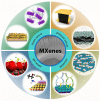MXenes and Their Applications in Wearable Sensors
- PMID: 32373590
- PMCID: PMC7187791
- DOI: 10.3389/fchem.2020.00297
MXenes and Their Applications in Wearable Sensors
Abstract
MXenes, a kind of two-dimensional material of early transition metal carbides and carbonitrides, have emerged as a unique class of layered-structured metallic materials with attractive features, as good conductivity comparable to metals, enhanced ionic conductivity, hydrophilic property derived from their hydroxyl or oxygen-terminated surfaces, and mechanical flexibility. With tunable etching methods, the morphology of MXenes can be effectively controlled to form nanoparticles, single layer, or multi-layer nanosheets, which exhibit large specific surface areas and is favorable for enhancing the sensing performance of MXenes based sensors. Moreover, MXenes are available to form composites with other materials facilely. With structure design, MXenes or its composite show enhanced mechanical flexibility and stretchability, which enabled its wide application in the fields of wearable sensors, energy storage, and electromagnetic shielding. In this review, recent progress in MXenes is summarized, focusing on its application in wearable sensors including pressure/strain sensing, biochemical sensing, temperature, and gas sensing. Furthermore, the main challenges and future research are also discussed.
Keywords: MXenes; biosensor; gas sensor; pressure sensor; strain sensor.
Copyright © 2020 Xin, Li, Ma, Pan and Shi.
Figures





References
-
- Alhabeb M., Maleski K., Anasori B., Lelyukh P., Clark L., Sin S., et al. (2017). Guidelines for synthesis and processing of two-dimensional titanium carbide (Ti3C2Tx MXene). Chem. Mater. 29, 7633–7644. 10.1021/acs.chemmater.7b02847 - DOI
-
- An H., Habib T., Shah S., Gao H., Patel A., Echols I., et al. (2019). Water sorption in MXene/polyelectrolyte multilayers for ultrafast humidity sensing. ACS Appl. Nano Mater. 2, 948–955. 10.1021/acsanm.8b02265 - DOI
-
- Anasori B., Lukatskaya M. R., Gogotsi Y. (2017). 2D metal carbides and nitrides (MXenes) for energy storage. Nat. Rev. Mater. 2:16098 10.1038/natrevmats.2016.98 - DOI
Publication types
LinkOut - more resources
Full Text Sources

